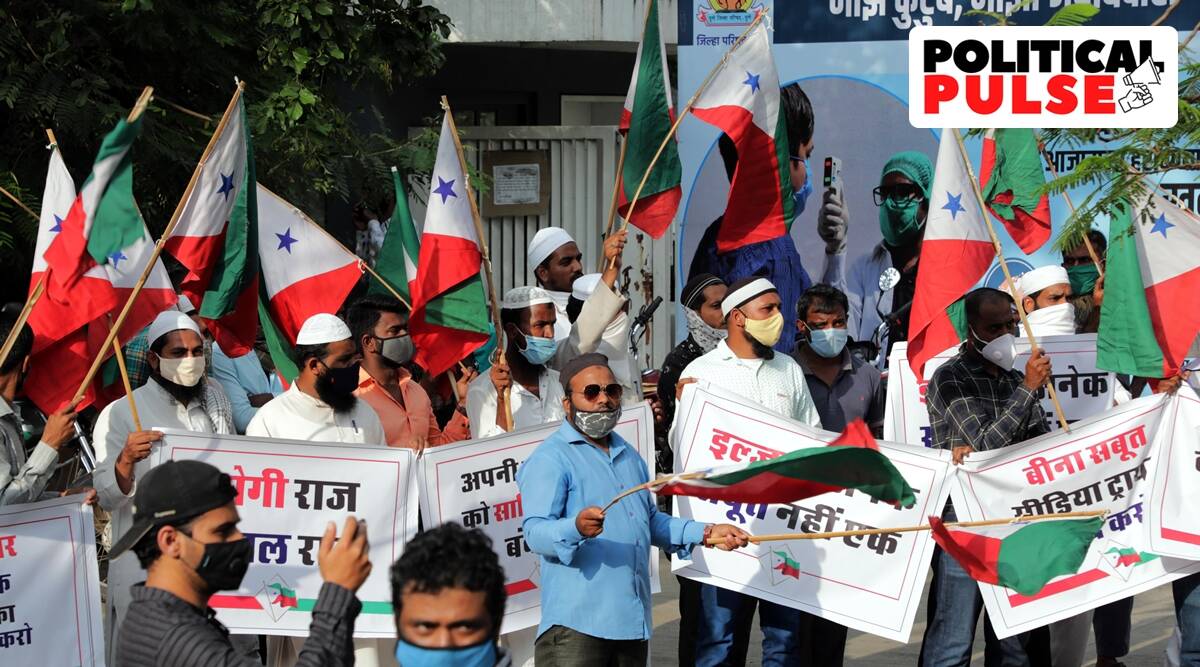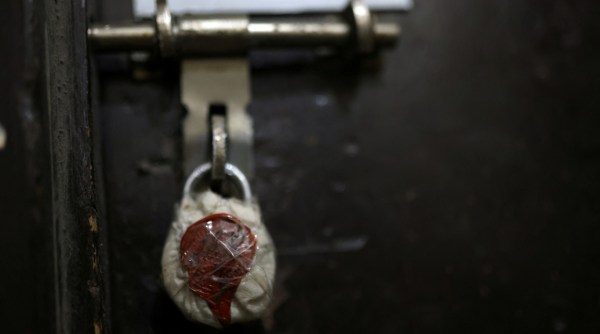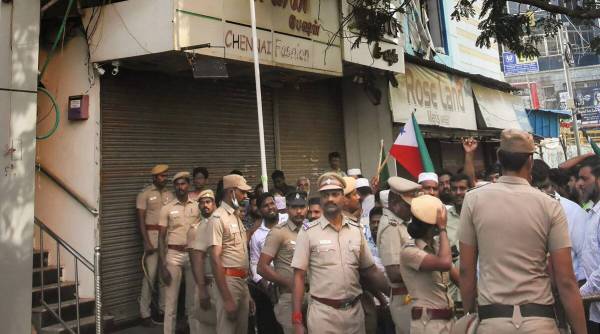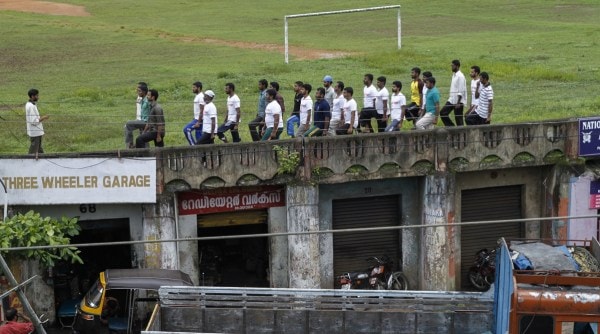 Activists of the Popular Front of India (PFI) at a protest in Uttar Pradesh in 2018. (Express file photo by Arul Horizon)
Activists of the Popular Front of India (PFI) at a protest in Uttar Pradesh in 2018. (Express file photo by Arul Horizon)At Puthanathani in Kerala’s Malappuram district, the green-and-red flags of the Popular Front of India (PFI) have disappeared from the lampposts by the wayside on Thursday, a day after the September 27 ban. Days earlier, in a pre-dawn swoop on September 23, the National Investigation Agency (NIA) had arrested five men, including PFI vice-chairman E M Abdul Rahiman and general secretary Anis Ahamed.
However, at Puthanathani, where the PFI has grown into a force over the years, and the now deserted Malabar House, a convention centre-cum-residential training facility that’s backed by the outfit, there is a quiet defiance.
“It is only the name that can be banned, but for us, PFI is an attitude against the Sangh Parivar and its fascism. A ban will not serve to silence us. There have been so many organisations that have come up over the years (to take on the RSS). Whenever they have been banned or restricted in some way, they have regrouped and come up with another outfit,’’ says a 50-year-old long-time PFI activist at Puthanathani.
Before the PFI and eight of its affiliates were banned, the outfit has treaded a long path, making steady inroads into Kerala society and politics. But during their three-decade journey, often stained by violence and terror, the outfit has constantly shifted shapes and forms, alternating between a benevolent social organisation and the face of radical, right-wing identity politics.
With a bunch of its national and state-level leaders behind bars following the NIA raids, and 2,000-odd workers and sympathisers in Kerala in judicial custody in connection with the violence during last week’s hartal that followed the ban, the right-wing Muslim outfit and the social base they catered to are at a critical juncture.
The beginnings
The 1980s were volatile times in Nadapuram, a town in eastern Kozhikode that has a long history of violence between cadres of the CPI(M) and the Indian Union Muslim League (IUML), a constituent of the Congress-led United Democratic Front. Over time, the political clashes took on a communal turn as the socially backward Hindu Thiyya community was seen to be on the CPM’s side, while the IUML had the backing of the Muslim community, flush with remittances from the Gulf.
By the end of that decade, as the rift between the communities widened, a group of Muslims at Nadapuram, who grouped under the banner of the Muslim Cultural Centre (MCC), started getting trained at local kalari (a form of martial arts) centres in the region in an attempt to take on the CPM.
 The PFI office in New Delhi: Locked and sealed. PTI
The PFI office in New Delhi: Locked and sealed. PTI In 1989, as the conflict built up in Nadapuram, MCC men knocked on the doors of E Aboobacker, a Muslim leader who had then stepped down as state president of the Students’ Islamic Movement of India (SIMI), to seek his guidance. The group decided that there was a need to build an organisation with a long-term strategy to defend Islam, both physically and intellectually.
On October 12, 1989, Aboobacker and the MCC youths floated the Babri Masjid Protection Committee. The outfit, which soon expanded outside Nadapuram with new units in Kozhikode, Thrissur and Malappuram, capitalised on the sense of insecurity then prevailing among Muslims in the backdrop of the Mandir-Masjid controversy and L K Advani’s rath yatra of 1990. That year also saw Muslim cleric Abdul Nasser Madani launching the Islamic Sevak Sangh (ISS). Madani’s fiery speeches attracted youths to his ISIS, which was seen as a radical Islamic counter to the RSS. On December 10, 1992, four days after the Babri Masjid demolition, the Centre banned ISS, leaving the radical elements rudderless.
On November 14, 1993, almost a year after the ISS was banned, the National Development Front (NDF) was set up with Aboobacker and P Koya, both with SIMI backgrounds, at its helm. The new outfit attracted several fringe groups, besides the militant MCC of Nadapuram.
Recalling the events that led to the formation of the NDF, Aboobacker, who would go on to be PFI chairman, writes in his recently published autobiography, Sisira Sandhyakal, Greeshma Madhyannangal (Winter Evenings, Summer Afternoons), “The issues raised by Madani lay at the bottom of society, unattended. Madani had attracted youths, but could not show them the way ahead.”
“NDF was broadminded to embrace people from all organisations. They didn’t have to sever their ties with these outfits or compromise on their identities within Islam… Hence, Sunnis and Mujahideen Muslims, who otherwise don’t sit together, shared the same venue at NDF events,” he wrote.
The flexibility given to NDF cadres to continue in their existing religious organisations helped the outfit grow horizontally, with its cadres even finding a toehold in political parties.
 Security personnel speak with Popular Front of India (PFI) workers protesting against the raid of NIA at the PFI office, in Chennai (PTI photo)
Security personnel speak with Popular Front of India (PFI) workers protesting against the raid of NIA at the PFI office, in Chennai (PTI photo) While it projected itself as a human rights outfit, taking up Dalit causes and openly fighting for a better share for Muslims and Dalits in government jobs, the NDF soon became a rallying point of fringe elements.
According to a former DGP, who has served as state intelligence chief, “As the IUML took a secular, moderate stand on most issues, the NDF was able to attract militant elements in the community. After the demolition of the Babri Masjid, several extremist groups had surfaced in Kerala. They all found their way into the NDF. The dominant sentiment among these hardliners was that the IUML was not strong enough to take on the BJP.’’
In a landscape stained with political killings and revenge attacks, what set the NDF apart, says ex-DGP, was that its actions, even while targeting CPI(M) and BJP cadres, were communal rather than political.
“They (NDF) mostly targeted Hindus. For instance, Hindu men in relationships with Muslim women were attacked and killed. As the NDF grew stronger, mainstream political parties clandestinely backed the outfit as an alternative to the IUML. This political patronage hampered the probe into several of the killings the outfit carried out,’’ he added.
One of the most sensational murders allegedly committed by NDF cadres was the killing of a CPI(M) worker, E Binu, who was accused of raping a Muslim woman, at Nadapuram in 2001. The murder had sparked large-scale violence in Nadapuram. Later, a police probe revealed that the allegation of rape was baseless.
 Security personnel stand guard outside the RSS office in Kochi. PTI
Security personnel stand guard outside the RSS office in Kochi. PTI In 2005, RSS Kannur baudhik pramukh T Ashwini Kumar was dragged out of the bus he was travelling in and hacked to death in full public view. The next year, Hindu Co-ordination Committee leader N Sunil Kumar was killed at Kilimanoor in Thiruvananthapuram in a hit-and-run attack. Both attacks were traced to the NDF.
The NDF, too, lost its men in clashes with CPI(M) and BJP cadres. In Kannur, where the two political rivals have for long targeted each other, the NDF added another violent dimension.
By the end of 2000, the NDF began to expand outside the state, with its leaders travelling to remote villages in the North and Northeast to build the organisation. Down south, versions of the NDF, the Karnataka Forum for Dignity (KFD) and Tamil Nadu’s Manitha Neethi Pasarai, had already made their presence felt.
The birth of PFI
In November 2006, a new outfit, the Popular Front of India (PFI), was formed as a common platform to bring together the NDF, KFD and MNP and as an answer to the need for a pan-India right-wing socio-political outfit to take on the Sangh. Since the transformation of NDF to PFI was not ideological but only geographical, the radical stream within the NDF seamlessly flowed into the PFI.
Even as its footprint expanded to 20 states, the PFI retained its Kerala face with its entire top leadership, including chairman OMA Salam, vice-chairman E M Abdul Rahman and national secretary Nasarudheen Elamaram, among several others, hailing from the state.
PFI soon set up a number of feeder organisations such as the Kerala Women’s Front, Campus Front, Confederation of Human Rights Organisations and the All India Imams Council. As it did so, the PFI found its place at the table of respected Muslim bodies such as the All-India Muslim Personal Law Board and the All India Milli Council and ended up establishing links with Muslim organisations abroad, including in Turkey.
With funds from abroad, the PFI took up charitable activities under the banner of the Rehab India Foundation, an organisation set up in 2008 with the aim of helping destitute Muslims in Assam. The outfit encouraged its young members to pursue programmes such as Masters in Social Work and deployed them in the field. During the floods in Kerala and the pandemic of the last two years, volunteers of the PFI and its affiliate outfits had stepped in with relief operations, especially in Kerala and Karnataka.
The social, charitable face of the PFI got a further fillip with the launch in 2009 of a political party that it backed — the Social Democratic Party of India (SDPI). Sources said the idea behind launching a political party was to rid the PFI of the blame that its presence only served to polarise voters with no positive political engagement with members of the Muslim community.
 PFI members train in Kottayam, Kerala, in 2010. PTI file
PFI members train in Kottayam, Kerala, in 2010. PTI file The party has in the years since its formation broadened its catchment area beyond its Muslim vote base and attempted to bring other backward minorities and Dalits under one roof. Roy Arackal and Thulaseedharan Pallikal are among several prominent non-Muslims in the state leadership of the SDPI.
The SDPI is the only one among the PFI’s affiliates that has survived the Centre’s ban.
A decade into its formation, the SDPI has made its presence felt in local body elections — in Kerala, the party has 103 civic body members, while in Karnataka it has 225.
Even before the launch of the SDPI, the PFI had tested electoral waters by fielding an independent candidate from Mysore during the 2008 Assembly elections in Karnataka. Its candidate bagged 10,000 votes and finished fourth in the race.
PFI’s militant face
Despite branching off into charitable and political activities, the core of the PFI remained stridently militant, focused on taking up moralistic and religion-based causes.
In 2010, PFI cadres chopped off the palms of a college professor on charges of blasphemy — an incident that brought home the horrors of right-wing fundamentalism and evoked parallels with the Taliban.
PFI has also been accused of fuelling anti-CAA protests in the North. Besides, eight of its workers have been charge-sheeted in connection with allegedly inciting caste riots in Hathras following the gang rape of 19-year-old Dalit girl which led to her death in September 2020. PFI’s student wing, the Campus Front of India, has been at the centre of the recent hijab protests in Karnataka.
As evidence of the PFI’s hold on Muslim society, intelligence sources point to instances of when they allegedly infiltrated the ranks of security personnel.
Recently, a police constable in Idukki was dismissed from service on charges of leaking out data about BJP-RSS leaders to PFI men. Three other policemen are facing probe for leaking out sensitive data to the PFI. In Palakkad, a fire force personnel, said to be working at the behest of the PFI, was arrested on charges of abetting the murder of an RSS worker.
In recent months, the PFI in Kerala has retaliated within hours of an attack on its cadres, a readiness that security sources attribute to the presence of hit-gangs within the outfit’s ranks.
PFI’s venture into the media business helped it spread its agenda further. In 2006, the organisation set up Thejas, a Malayalam daily aimed at the Muslim community. With its noticeably distinct slant on issues such as militancy in Kashmir (it refers to militants as “fighters”), the newspaper carried sensational stories on issues such as alleged police atrocities, human rights, and ‘fake encounters’.
In 2013, the management of the daily moved the High Court after the government turned the tap off on advertisements for Thejas. The government then told the court that “PFI has a clandestine agenda of Islamisation of society by promoting conversion… and maintenance of a branded committed indoctrinated Muslim youth for undertaking actions including selective elimination of persons, who in their perception are enemies of Islam.’’
Squeezed of government ads, and with its local advertisers under the scanner of security agencies, Thejas shut down its print operations on December 31, 2018; it still has a digital presence.
Over the years, PFI’s agenda has opened new frontiers of tension and turmoil within the Muslim community with its militant stand on community issues forcing other Muslim outfits to reposition themselves more to the right.
PFI has in several instances, including the sensational Hadiya case, faced allegations of abetting religious conversion. Hadiya is said to have stayed at Sathya Sarani, the only institute in Kerala that offers a two-month residential programme for new converts to Islam and which is run by a trust that has PFI members.
According to investigators, a few of the PFI’s cadres even migrated to Syria to join the Islamic State. The NIA had in 2017 traced the ‘Kannur module of the IS’ to the PFI — around 15 PFI men from Kannur had allegedly either migrated to or tried to migrate to Syria. A few of them are said to have been killed in strikes there. One of them, Abu Thahir from Palakkad, had worked with Thejas.
Incidentally, it was in Kannur (Narath village) that police in 2013 busted an arms and explosives training camp allegedly run by the PFI.
With the ban bringing down the curtains on the PFI, at least for now, the question that is now being asked is, what happens to the vote bank and support base they left behind.
In a state where electoral victory margins have traditionally been narrow, the way political parties respond to this vote bank will keep Kerala politics alive.
While the BJP has already accused the CPI(M), Congress and IUML of vying with one another for the PFI vote bank,
Insisting the IUML won’t take in any of the PFI cadres, senior IUML leader Dr M K Muneer says, “Leading Muslim religious organisations and the IUML have always campaigned against the PFI, warned youths against embracing its ideology. But some immature minds got lured by the PFI. Now, with no leadership to guide them, these youngsters will face a sense of uncertainty and insecurity in the coming days. A section of the PFI may even turn apolitical. But the IUML won’t accept any of their cadres or leaders,’’ said Muneer, adding that the IUML would stick to its stand taken in the past against dual membership (in the IUML and PFI). “We are a secular party and the PFI has been splitting secular votes,’’ he said.
Political observer Fakhruddin Ali predicted that the ban could end up energising the SDPI. “There is a chance that SDPI will become more mainstream. Alternatively, mainstream parties will attempt to win over the PFI vote bank,’’ he said.